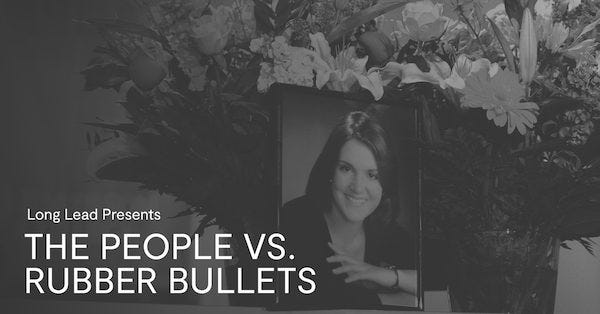A Shot in the Dark
View this email in your browser
One day after Boston Red Sox fan Victoria Snelgrove was killed by a police officer firing a FN303 pepper ball gun, a Boston Globe editorial proclaimed the weapon “has no place in a Boston policeman’s hand until it is made safe.” And the city’s law enforcement never picked up the deadly “less-lethal” launcher again.
Of course, correlation does not equal causation. The reasons Boston scrapped its FN303s can be found in the pages of three separate investigations launched by former Boston Police Commissioner Kathleen O’Toole in the wake of the 21-year-old’s death.
In Part IV of The People vs. Rubber Bullets, out today, Linda Rodriguez McRobbie interviews an introspective O’Toole almost two decades after Snelgrove’s shooting and compiles the definitive reckoning of this tragic 2004 event.
A Boston police officer aims an FN303 pepper ball gun at the crowd outside Fenway Park. Mary Knox Merrill / Associated Press
Snelgrove’s death is devastating for many reasons, but the most gutting may be that many experts saw it as easily avoidable. Instinctively, O’Toole — a mother of a young woman the same age as Snelgrove — knew to steer clear of the area that night. “Just promise me, if the Red Sox win tonight, you will not go to Kenmore Square,” McRobbie reports O’Toole told her daughter. “Promise me.”
Shot in the eye with a pepper ball while trapped in a racous post-game crowd, Snelgrove was pronounced dead 12 hours later, the bullet having shattered and pushed ocular bones into her brain. Since that October 2004 day, time has marched on for everyone but Snelgrove and her loved ones — a tragic phenomenon shared by other victims of less-lethal shootings. And as the Red Sox went on to a historic World Series win, to many people, her name lingers as a sad footnote, an “L” in the box score of that night that should haunt all of us forever.
Read Part IV of “The People vs. Rubber Bullets” here:
A photograph of Victoria Snelgrove, who was killed by pepper ball fired by Boston police in 2004, appears at a memorial one year after her death. David L Ryan / The Boston Globe / Getty
Replying to a request for further information on this killing, Suffolk County District Attorney’s office asked me why we are covering this now — was there an anniversary or something? It’s a good question. Snelgrove died 18 years ago last month, not exactly a round number. But the lessons learned by the Boston Police following her death still haven’t been heeded. Though Boston scrapped its FN303s, other cities didn’t follow suit. Photos show the deadly launchers were used to on protestors in the summer of 2020.
Anniversaries aren’t necessary in covering an ongoing crisis. And journalism like The Boston Globe editorial, and like this multi-part series highlighting less-lethal victims are necessary to change the course of this injustice. Don’t just take my word for it — listen to Linda Tirado, a journalist who survived a less-lethal shot in the eye in 2020. “There will be a next time,” she tells McRobbie in the next installment of The People vs. Rubber Bullets, out in December. “They will shoot another journalist in the face.”
Thanks for reading. Until then…
John Patrick Pullen
Founding Editor, Long Lead
PS: If you’ve read this far, I have a favor to ask. If you’re reading and enjoying The People vs. Rubber Bullets, please tell someone else about it, online, offline, however you can. Long Lead is ad-free and free to read, but to have an impact, we need more people to experience the immersive, in-depth journalism we’re producing. Thank you!
Read “The People Vs. Rubber Bullets”
Copyright (C) 2022 Long Lead, LLC. All rights reserved.
Want to change how you receive these emails?
You can update your preferences or unsubscribe








